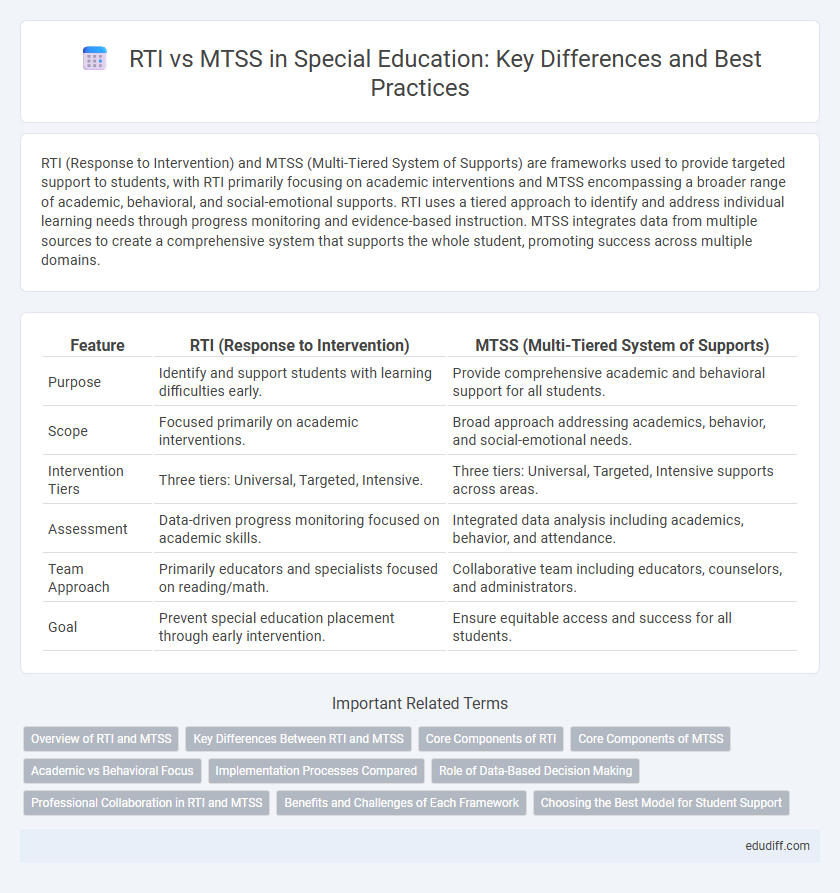RTI (Response to Intervention) and MTSS (Multi-Tiered System of Supports) are frameworks used to provide targeted support to students, with RTI primarily focusing on academic interventions and MTSS encompassing a broader range of academic, behavioral, and social-emotional supports. RTI uses a tiered approach to identify and address individual learning needs through progress monitoring and evidence-based instruction. MTSS integrates data from multiple sources to create a comprehensive system that supports the whole student, promoting success across multiple domains.
Table of Comparison
| Feature | RTI (Response to Intervention) | MTSS (Multi-Tiered System of Supports) |
|---|---|---|
| Purpose | Identify and support students with learning difficulties early. | Provide comprehensive academic and behavioral support for all students. |
| Scope | Focused primarily on academic interventions. | Broad approach addressing academics, behavior, and social-emotional needs. |
| Intervention Tiers | Three tiers: Universal, Targeted, Intensive. | Three tiers: Universal, Targeted, Intensive supports across areas. |
| Assessment | Data-driven progress monitoring focused on academic skills. | Integrated data analysis including academics, behavior, and attendance. |
| Team Approach | Primarily educators and specialists focused on reading/math. | Collaborative team including educators, counselors, and administrators. |
| Goal | Prevent special education placement through early intervention. | Ensure equitable access and success for all students. |
Overview of RTI and MTSS
Response to Intervention (RTI) is a multitiered approach designed to identify and support students with learning difficulties through targeted instruction and progress monitoring. Multi-Tiered System of Supports (MTSS) expands on RTI by integrating academic, behavioral, and social-emotional support systems within a unified framework. Both RTI and MTSS emphasize data-driven decision-making to promote student success and reduce the need for special education services.
Key Differences Between RTI and MTSS
RTI (Response to Intervention) primarily focuses on identifying and supporting students with learning difficulties through tiered interventions, while MTSS (Multi-Tiered System of Supports) offers a comprehensive framework addressing academic, behavioral, and social-emotional needs. RTI is often implemented solely for academic interventions, whereas MTSS integrates multiple support systems, including behavioral assessments and family engagement. The key difference lies in MTSS's holistic approach compared to RTI's narrower focus on academic skill improvement.
Core Components of RTI
RTI (Response to Intervention) emphasizes three core components: high-quality, research-based instruction, continuous progress monitoring, and multi-tiered levels of support tailored to student needs. The primary goal is early identification and intervention for struggling students through data-driven decision-making. These components ensure a systematic approach to improving academic outcomes within the RTI framework.
Core Components of MTSS
RTI (Response to Intervention) and MTSS (Multi-Tiered System of Supports) both emphasize early identification and support for students, but MTSS integrates academic, behavioral, and social-emotional components to provide a holistic approach. Core components of MTSS include universal screening, data-based decision making, tiered intervention levels, progress monitoring, and fidelity of implementation. These elements ensure systematic support tailored to diverse student needs, promoting success across academic and behavioral domains.
Academic vs Behavioral Focus
Response to Intervention (RTI) primarily targets academic challenges by providing tiered support designed to identify and assist students struggling with learning difficulties. Multi-Tiered System of Supports (MTSS) integrates both academic and behavioral interventions, creating a comprehensive framework that addresses a broader range of student needs. MTSS's inclusion of behavioral support enhances student engagement and outcomes beyond the academic emphasis found in RTI.
Implementation Processes Compared
RTI (Response to Intervention) and MTSS (Multi-Tiered System of Supports) differ primarily in scope and implementation processes, with RTI focusing narrowly on academic interventions and MTSS encompassing both academic and behavioral supports within a comprehensive framework. RTI implementation involves a structured, tiered approach emphasizing early identification and targeted instruction, while MTSS integrates data-driven decision-making across multiple domains to address diverse student needs holistically. Effective implementation of both models requires coordinated collaboration among educators, consistent progress monitoring, and fidelity to intervention protocols tailored to student response patterns.
Role of Data-Based Decision Making
Data-based decision making in RTI (Response to Intervention) and MTSS (Multi-Tiered System of Supports) plays a critical role in identifying student needs and customizing instructional strategies. RTI relies heavily on frequent progress monitoring data to determine students' responsiveness to interventions across tiers, ensuring timely adjustments. MTSS integrates academic, behavioral, and social-emotional data to provide a comprehensive framework for targeted support and continuous improvement.
Professional Collaboration in RTI and MTSS
Professional collaboration in Response to Intervention (RTI) and Multi-Tiered System of Supports (MTSS) centers on interdisciplinary teams working together to identify and address student needs through data-driven decision-making. Educators, specialists, and administrators coordinate interventions and monitor progress to ensure equitable access to instructional supports across Tier 1, Tier 2, and Tier 3 levels. This collaborative approach enhances communication, aligns resources, and fosters a unified effort to improve student outcomes within both RTI and MTSS frameworks.
Benefits and Challenges of Each Framework
RTI (Response to Intervention) offers benefits such as early identification of struggling students through tiered support, data-driven decision-making, and prevention of academic failure by providing targeted interventions. Challenges of RTI include the need for consistent progress monitoring and potential delays in addressing behavioral issues due to its academic focus. MTSS (Multi-Tiered System of Supports) provides a more comprehensive approach by integrating academic, behavioral, and social-emotional supports, promoting a holistic view of student needs and personalized intervention plans. Challenges within MTSS encompass the complexity of implementation across multiple domains and the requirement for extensive staff training to ensure fidelity across tiers.
Choosing the Best Model for Student Support
Selecting the most effective framework for student support involves comparing RTI (Response to Intervention) and MTSS (Multi-Tiered System of Supports). RTI primarily targets academic interventions through a tiered approach based on student performance data, while MTSS integrates both academic and behavioral support within a comprehensive system. Schools aiming for holistic student development often prefer MTSS due to its broader scope and collaborative problem-solving strategies.
RTI vs MTSS Infographic

 edudiff.com
edudiff.com